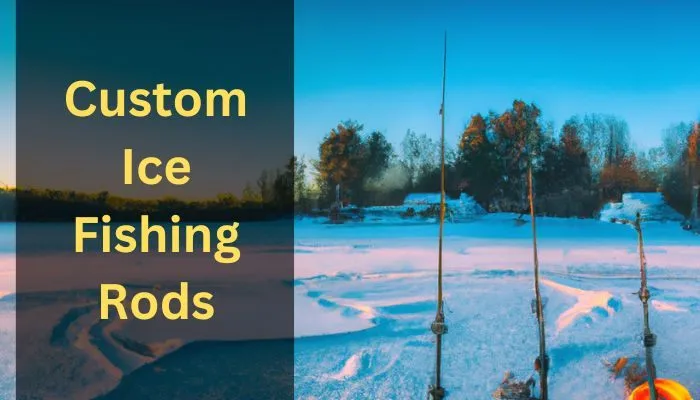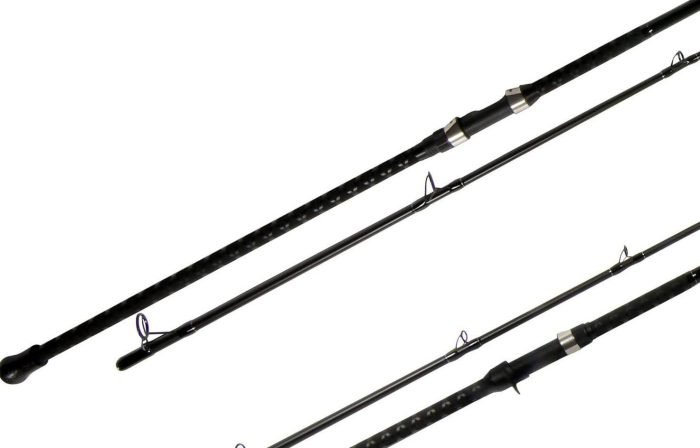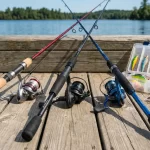Do you want to impress your fishing buddies with your casting accuracy? Or maybe you’re tired of constantly missing your target and want to improve your skills.
Whatever your reason, improving your casting accuracy requires practice and technique. But fear not; with a little bit of effort and the right approach, you can become a pro at casting in no time.
First and foremost, it’s important to understand the basics of casting techniques. From the grip on your rod to the motion of your arm, every little movement can affect your accuracy. But don’t worry; we’ll break it down for you in detail.
Additionally, practicing regularly is essential to improving your skills. Even just a few minutes a day can make a significant difference. So grab your rod, and let’s get started on the path to becoming a casting master.
Understand the Basics of the Casting Technique
Mastering the fundamentals of casting technique is essential for achieving pinpoint precision and consistent results. To improve your casting accuracy, start by understanding the basics of body mechanics and body positioning.
Proper body mechanics help you generate more power and control in your cast. For example, when casting with a fly rod, keep your elbow close to your body and use your entire arm, not just your wrist, to create a smooth, powerful motion.
In addition to body mechanics, line management and line control are crucial elements of casting accuracy. Proper line management starts with having the right amount of line outside of the rod tip.
Too little line, and you won’t be able to achieve enough momentum for an accurate cast. Too much line, and you’ll lose control, resulting in messy loops and poor accuracy.
Once you have the right amount of line, focus on controlling it with your non-dominant hand while using your dominant hand to cast. This will help you achieve a consistent and accurate cast every time.
Practice Regularly
To get better at hitting your target, make sure you’re regularly practicing casting techniques and honing your skills.
According to a study by the University of Memphis, those who practice consistently saw a 23% increase in accuracy compared to those who only practice occasionally.
To make the most out of your practice sessions, here are three things you can do:
- Importance of feedback: It’s essential to get feedback from someone who knows what they’re doing. This can be a casting instructor, a fishing buddy, or even a video of yourself casting. Feedback helps you identify areas where you need improvement and gives you a benchmark to measure your progress.
- Incorporating different targets: Don’t limit yourself to casting at the same target every time. Varying the distance, height, and angle of your target will help you develop the ability to adjust your casting technique to different situations. This skill is crucial in real-life fishing scenarios, where you never know what kind of casting situation you’ll encounter.
- Consistency is key: Practicing regularly is more important than practicing for long periods at irregular intervals. Set aside a specific time each day or week for practice and stick to it. Even if you only have a few minutes, practicing consistently will help you develop muscle memory and improve your technique over time.
By following these tips, you’ll be well on your way to improving your casting accuracy and becoming a better angler. Remember, practice makes perfect, but practicing smart will get you there faster.
Choose the Right Equipment
Choosing the right equipment can greatly impact the success of your fishing endeavors. Selecting gear that’s the right length, weight, and material for the type of fishing you’ll be doing can make all the difference in your casting accuracy.
For example, a longer rod might give you more distance, but a shorter one might be more accurate for a specific type of fishing. Additionally, the weight of your rod can affect how easy it is to cast, so it’s important to choose one that fits your personal preferences.
Once you have your equipment, it’s important to find instructions on how to use it properly. Even if you’ve been fishing for years, there’s always room for improvement and learning new techniques.
Look for resources like online tutorials, instructional videos, or even local classes or workshops. Getting feedback from others can help you identify areas where you need to improve and give you a better understanding of how to use your equipment to its fullest potential.
By taking the time to select the right gear and learn how to use it properly, you can greatly improve your casting accuracy and increase your chances of having a successful fishing trip.
See also: The Top 5 Best Value Spinning Rod Reel Combos
Adjust for Wind and Other Conditions
When fishing, it’s important to understand the wind direction and speed, as it can greatly affect your casting accuracy. You should adjust your casting angle and power accordingly to compensate for the wind.
Additionally, different water conditions require different adaptations, so it’s important to be aware of these conditions and adjust accordingly for optimal results.
Remember to pay close attention to these factors to ensure a successful fishing trip.
Understanding Wind Direction and Speed
Knowing the direction and speed of the wind is crucial in determining where your bait will land, as shown by the experienced angler who missed several bites until they started paying attention to the wind. To accurately cast your line, you need to understand how the wind will affect it.
Here are some things to keep in mind when it comes to wind direction and speed:
- Wind direction: The direction of the wind will determine where your bait will land. If the wind is blowing towards you, you’ll need to adjust your cast accordingly to avoid getting your line tangled in the wind. If the wind is blowing away from you, you’ll need to cast further to reach your desired spot.
- Wind speed: The speed of the wind will also affect your casting accuracy. If the wind is too strong, it’ll carry your bait away from your intended target. If the wind is too weak, your bait may fall short of your desired spot. It’s important to practice casting at different wind speeds to get a feel for how it affects your cast.
- Reading water: It’s important to read the water to determine wind direction. Look for ripples on the water’s surface or the movement of objects like leaves or grass to determine which way the wind is blowing.
- Adjusting your cast: To adjust for wind direction and speed, you may need to change the angle of your cast or the strength of your cast. This takes practice and experience, but with time, you’ll be able to cast accurately in any condition.
By understanding wind direction and speed and adjusting your cast accordingly, you’ll be able to improve your casting accuracy and increase your chances of catching fish. Remember to practice in different conditions and pay attention to the wind to become a more skilled angler.
Adjusting Casting Angle and Power
To become a more skilled angler, it’s important to adjust the angle and power of your cast according to the conditions. This allows you to catch more fish and have a better overall fishing experience.
One of the first things to consider is your grip. Make sure that you have a proper grip on your rod, with your fingers wrapped around the handle and your thumb on top. This will give you the control you need to adjust your casting angle and power.
Your body position is also important when adjusting your cast. To cast more accurately, stand with your feet shoulder-width apart and face your target. Keep your body relaxed and your shoulders level.
As you prepare to cast, focus on the timing and follow through. The timing of your cast is crucial, as you want to release the line at the right moment to achieve the desired distance. And don’t forget the follow-through, as this will help you achieve a smooth and accurate cast.
By adjusting your casting angle and power and paying attention to your grip, body position, timing, and follow-through, you’ll be well on your way to becoming a more skilled angler.
Adapting to Different Water Conditions
Adapting to different water conditions can enhance your fishing experience, so be mindful of your surroundings and adjust your approach accordingly.
One key factor to consider is water clarity. In clear water, fish are more easily spooked and can see your line and bait more clearly.
To improve your casting accuracy in clear water, use lighter lines and lures that closely match the natural prey of the fish in that area. Additionally, you may need to cast further away from the fish to avoid scaring them.
Surface disturbances, such as wind or waves, can also impact your casting accuracy. In windy conditions, it may be necessary to adjust your casting angle and power to compensate for the wind’s direction and speed.
You may also need to use heavier lures to help them sink below the surface and reduce the impact of the wind on your line.
When fishing in choppy waters, try to cast into the troughs between the waves where the fish may be seeking shelter. By adapting your casting technique to the water conditions, you can increase your chances of a successful fishing trip.
Learn from Experienced Anglers
Experienced anglers have a wealth of knowledge to share on perfecting your cast, so take advantage of their expertise. Techniques for finding experienced anglers include attending fishing events, joining local fishing clubs, and engaging with other anglers on social media.
Once you’ve found an experienced angler, take the time to observe their casting technique and ask for tips on improving your form.
The benefits of learning from experienced anglers go beyond just improving your casting accuracy. They can also teach you about different types of fish, the best times of day to fish, and how to read the water.
Plus, you’ll have the opportunity to connect with other like-minded individuals who share your passion for fishing. So don’t be afraid to reach out and learn from those who have been fishing for years – you’ll be surprised at how much you can improve your skills and knowledge.
Frequently Asked Questions
What are the most common mistakes that beginners make when casting?
As a beginner, it’s easy to feel overwhelmed by the complexity of casting. One common mistake that many beginners make is gripping the rod too tightly, which can lead to a lack of control and accuracy.
Another mistake is using too much force when casting, which can cause the line to tangle or the fly to land too aggressively on the water. To improve your casting accuracy, try loosening your grip and using a lighter touch when casting.
Focus on making smooth, fluid movements and using your wrist to control the line. Remember to keep your elbow close to your body and to use your whole arm when casting.
With practice and patience, you’ll soon be casting like a pro.
How can I tell if I am using the wrong type of equipment for my casting style?
To ensure optimal performance when casting, it’s crucial to select the proper equipment that aligns with your casting style. Proper equipment selection involves a thorough analysis of your casting technique to identify the right rod, reel, and line type.
This requires technical knowledge and attention to detail to identify the nuances of your technique and how they may be impacted by the equipment. By investing the time to select the correct gear, you can improve your casting accuracy and overall performance.
So, take the time to analyze your casting technique and invest in the proper equipment to maximize your potential on the water.
Is there a specific time of day or weather condition that is best for practicing casting?
To maximize your chances of improving your casting accuracy, it’s essential to consider the best time and weather conditions for practicing.
Typically, the best time for casting is in the early morning or late afternoon when the temperature is cooler and the wind is calmer. Avoid practicing in the middle of the day when the sun is high and the winds are stronger.
As for weather conditions, overcast or slightly cloudy days are ideal as they provide softer light and less glare, making it easier to see your target. Additionally, casting in calm conditions will help you focus on your technique, as the wind can make it challenging to maintain proper form.
By carefully selecting the best time and weather conditions for practicing, you’ll be able to develop your casting skills with greater accuracy and precision.
What are some tips for casting in tight spaces or around obstacles?
Tight spaces and obstacles can pose a challenge when it comes to casting accuracy, but don’t let that deter you. With practice techniques and adjusting your gear, you can still cast with precision.
One technique is to use a sidearm cast, which allows you to keep your line low and avoid obstacles. Additionally, adjusting the length of your leader can help you cast in tight spaces.
It’s also important to pay attention to your surroundings and adjust your casting accordingly. With patience and practice, you’ll be able to cast accurately, even in the most challenging of spaces.
So don’t be afraid to try new techniques and adjust your gear to suit your needs.
How can I improve my accuracy when casting to moving targets, such as fish swimming in a stream or river?
To improve your accuracy when casting to moving targets like fish swimming in a stream or river, you need to practice techniques that will help you hit your target with precision.
One effective technique is to practice your casting on land, focusing on your body position and the speed and direction of your cast.
Seeking guidance from experienced anglers or taking a casting class can also help you refine your technique, allowing you to make accurate casts even when faced with challenging conditions.
With practice and guidance, you can develop the skills you need to successfully cast to moving targets and increase your chances of landing that big catch.
Conclusion
Congratulations, you’ve made it to the end of this article on how to improve your casting accuracy! By now, you should have a better understanding of the basics of casting technique, the importance of regular practice, the significance of choosing the right equipment, and the need to adjust for wind and other conditions.
But how can you continue to improve your skills even further? One way is to learn from experienced anglers.
These experts have spent countless hours on the water, perfecting their craft and honing their skills. They can offer valuable insights and advice on everything from casting techniques to the best lures to use in any given situation. So, don’t be afraid to ask questions and seek out their guidance.
In the end, becoming a skilled angler takes time, patience, and dedication. But with the right mindset and approach, you can improve your casting accuracy and become a master of the water.
So, grab your gear, head out to the lake or river, and start practicing! And remember, as the old saying goes, ‘practice makes perfect.’








